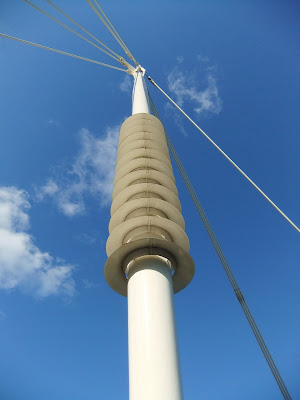This is a reminder of the North Easts mining heritage - 'Coals to Newcastle'
Boldon Colliery is just next to Jarrow and the mine even gave its name to the town - the Colliery itself closed just before the miners strike in 1983 - the Colliery was founded in 1878 when the first shaft was sunk.
Boldon Colliery pit shaft eventually went on to reach a depth of 1500 feet with numerous
coal seams in the strata which were identified as follows and showing the degrees of difficulty faced by the miners of Boldon.
The main seams were at 800 to 1500 feet below ground and were known as the Yard Coal Seam, the Bensham Seam, the Five Quarter Seam and the Final seam being called the Hutton Seam on the Wear and the Low Main on the Tyne.
137 Feet --- COAL 2 inch deep
238 Feet --- COAL, mixed with stone 1 foot deep
275 Feet --- COAL 6 inch deep
489 Feet --- COAL 1 foot 8 inch deep
502 Feet --- COAL 10 inch deep
535 Feet --- COAL 8 inch deep
588 Feet --- COAL 1 foot 5 inch deep
Grey Metal band 3 inches
COAL 1 foot 4 inch deep
719 Feet --- COAL 1 foot 8 inch deep
COAL 8 inch deep
COAL, mixed with stone 3 inches deep
769 Feet --- COAL 8 inches deep
Band 1 inch
COAL 5 inches deep
Band 1 inch
COAL 11 inch deep
814 Feet --- COAL 5 inch deep
833 Feet --- COAL 5 inch deep
890 Feet --- COAL 5 feet 4 inch deep
953 Feet --- COAL 1 foot 8 inch deep
1066 Feet --- COAL 1 foot 3 inch deep
1111 Feet --- COAL 3 feet deep
1223 Feet --- COAL 2 feet 6 inch deep
1246 Feet --- COAL 5 inch deep
1296 Feet --- COAL 9 inch deep
1300 Feet --- COAL 9 inch deep
1327 Feet - COAL 3 feet 4 inch deep (YARD COAL SEAM)
1384 Feet - COAL 5 feet 6 inch deep (BENSHAM SEAM)
1412 Feet - COAL 1 foot deep
1427 Feet - COAL 7 inch deep
1453 Feet - COAL 2 feet 6 inch deep (FIVE QUARTER SEAM)
1526 Feet - COAL 4 feet 9 inch deep (HUTTON SEAM (Wear) - LOW MAIN (Tyne))

























